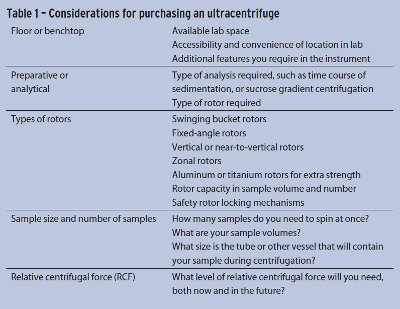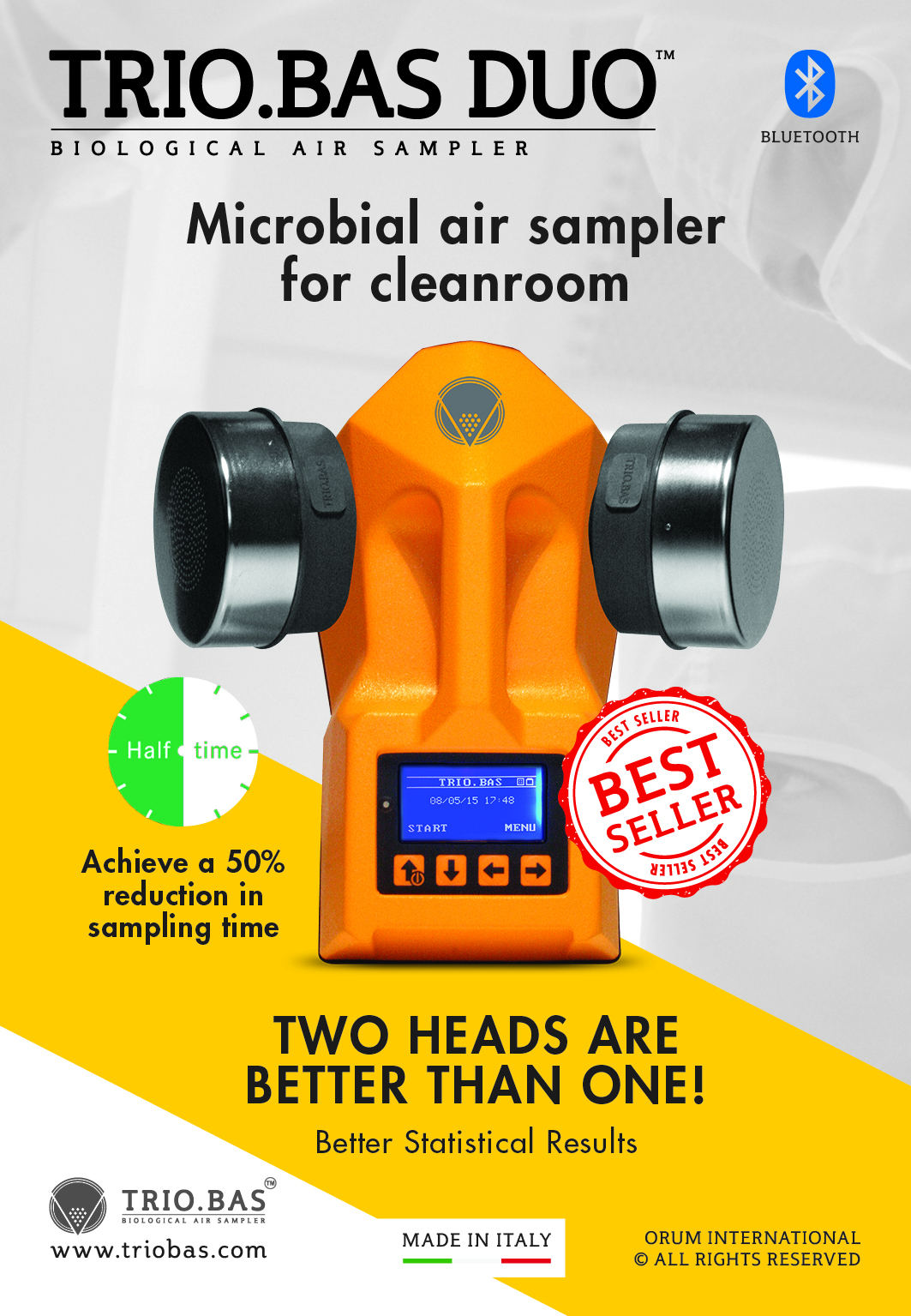Ultracentrifugation
Ultracentrifuges are a type of centrifuge designed to rotate samples at “ultrahigh” speeds (much higher than conventional centrifuges), with a rotational speed of up to 150,000 rpm, creating a centrifugal force up to more than 1 million × g. All centrifuges can separate species within a liquid according to density, but the high centrifugal acceleration of ultracentrifuges lets you focus in on those tiny differences among molecules like proteins or nucleic acids. But with a number of different types and models available today, it can be difficult to know which ultracentrifuge to choose for your own lab. The first step is to consider your present and future needs in ultracentrifugation, and the next step is to keep those needs in mind when learning about the ultracentrifuge options available today.
Ultracentrifuge applications
Ultracentrifuges are commonly used in molecular biology, biochemistry, and cell biology. Applications of ultracentrifuges include the separation of small particles such as viruses, viral particles, proteins and/or protein complexes, lipoproteins, RNA, and plasmid DNA.
Types of ultracentrifuges
Ultracentrifuges can be grouped into two types: analytical and preparative. The type you choose will depend on what you will be using it for (see below). Ultracentrifuges also come in larger floor models, or more compact benchtop models.
Analysis and methods using ultracentrifuges
Analytical and preparative ultracentrifuges differ in the way they are used in the lab. Analytical centrifugation can yield important information about molecules in your sample, such as their overall shape, conformational changes, and even the number and stoichiometry of subunits that comprise protein complexes. An example of a powerful analytical ultracentrifuge system is the ProteomeLab™ XL-A/XL-I from Beckman Coulter (Brea, CA; www.beckmancoulter.com).
Analytical ultracentrifuges incorporate a scanning visible/ultraviolet light-based optical detection system for real-time monitoring of the sample’s progress during a spin. This lets you watch the sedimentation process (or rather, a detector collects light absorption data, which a computer digitizes and records for you), allowing you to see the sample concentrate as the centrifugal force increases. The ProteomeLab XL-A/XL-I also contains an additional detection system in the form of Rayleigh interference optics, which measure changes in the refractive index that occur when the sample concentration changes. The benefits of this additional detection capacity are that it allows you to study a broader range of sample concentrations and more types of samples, with increased accuracy. The ProteomeLab XL-I model is capable of sequential data collection from both detection systems.
The two most common types of analysis performed with analytical ultracentrifuges are sedimentation velocity experiments and sedimentation equilibrium experiments. In sedimentation velocity experiments, the ultracentrifuge, detector, and computer record the time course of the sedimentation process, yielding information about the shape, mass, and size of the molecules. Sedimentation equilibrium experiments involve studying the steady-state equilibrium of the sample in solution. Even after sedimentation is completed, the sample exists in steady-state equilibrium with the solute down its concentration gradient. This type of analysis gives information about mass and chemical equilibrium constants.
Preparative ultracentrifuges are often used for separating particles according to their densities, isolating and/or harvesting denser particles for collection in the pellet, and clarifying suspensions containing particles. Sometimes researchers also use preparative ultracentrifuges if they need the flexibility to change the type of rotor in the instrument. Preparative ultracentrifuges can be equipped with a wide range of different rotor types, which can spin samples of different numbers, at different angles, and at different speeds (see below).
Considerations for purchasing an ultracentrifuge

Ultimately, the best ultracentrifuge will be the one that best serves your lab’s needs. There are several key points to consider that will make the process of choosing an ultracentrifuge easier (see Table 1).
Floor or benchtop
Ultracentrifuges come in two basic styles—larger floor models, such as the Thermo Scientific (Waltham, MA; www.thermoscientific.com) Sorvall™ WX Floor Ultracentrifuge and the Beckman Coulter Optima™ XE; and smaller, compact benchtop models that save on lab floor space, such as the Thermo Scientific Sorvall MTX 150 Micro-Ultracentrifuge and the Beckman Coulter Optima MAX-XP™. The type of model you choose partly depends on your available lab space, or particular protocols, but also on the other features discussed below.
Preparative or analytical
Given the differences between the uses described above for preparative and analytical ultracentrifuges, consider your current or future experiments, as well as the kinds of information you’d like to extract. If you’re likely to use the ultracentrifuge for pelleting small particulate materials such as viruses, membranes, and organelles, or smaller particles such as DNA or RNA, then a preparative ultracentrifuge might be best. In addition, preparative ultracentrifuges are well-suited for gradient separations, in which the molecular species in a sample are separated using a substance of graduated density, such as sucrose gradients for proteins or organelles, or cesium gradients for nucleic acids. On the other hand, if you want to examine the mass and shape of macromolecules or protein complexes, or plan to study molecules during the time course of sedimentation, an analytical ultracentrifuge might be more appropriate.
Types of rotors
In most preparative ultracentrifuges, you can swap out the rotor and replace it with another type. The type of rotor you use depends on your particular samples and experiments, but there are several main types to consider. Most rotors have openings in which to place sample tubes of a particular size or volume. Fixed-angle rotors contain openings for sample tubes at a fixed angle from the central axis. Other rotors accommodate vertical or near-to-vertical sample tubes. Swinging bucket rotors consist of a ring of individual tube holders on hinges that allow the tubes to swing outward when spinning begins. The result is that during centrifugation, the tubes are horizontal and aligned with the direction of force. Exceptions to multisample types of rotors are zonal rotors, which are designed to hold one sample of a larger volume instead of multiple sample tubes. Another useful feature of some rotors is a self-locking mechanism that makes rotor installation easier and operation safer.
Sample size and number of samples
Most ultracentrifuges use standard sizes of centrifuge tubes, with typical sample volumes that range from 0.2 mL to 30 mL. Other less common or customized sample volumes are possible, but it is important to make sure that you can also find an appropriate rotor that is compatible with both the sample tube and the type of ultracentrifugation you need.
Relative centrifugal force (RCF)
The types of experiments that you run or plan to run in the future will primarily dictate the required RCF. RCF is determined by two factors—the radius of the rotor and the rotational speed squared. Different applications sometimes require different amounts of force, so research which one is most appropriate for you. Likewise, it might be a waste of funds to purchase an ultracentrifuge with a higher RCF than you will ever need.
With these considerations in mind, you’ll be well-prepared when perusing the available options. The technologically advanced and user-friendly features included in nearly all ultracentrifuges today will make it that much easier to choose the model that’s right for you.
Caitlin Smith is a freelance science writer who has a Ph.D. in Neuroscience from Yale University and postdoctoral work in Electrophysiology and Synaptic Plasticity; e-mail: caitlin.smith@comcast.net.

















